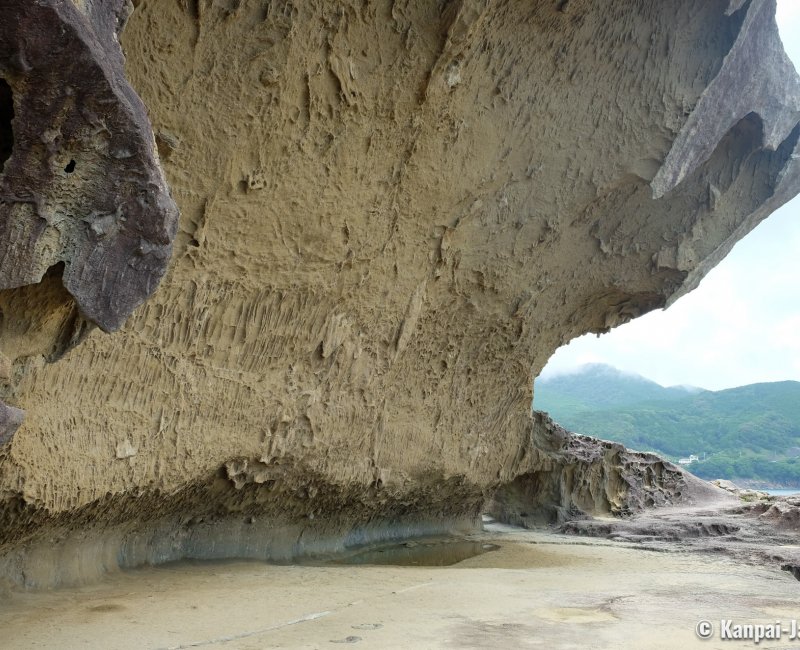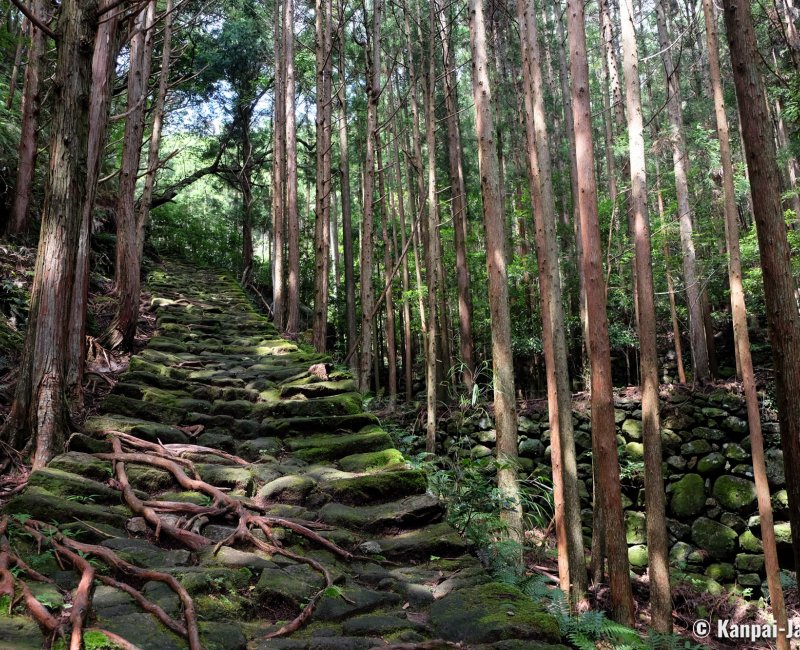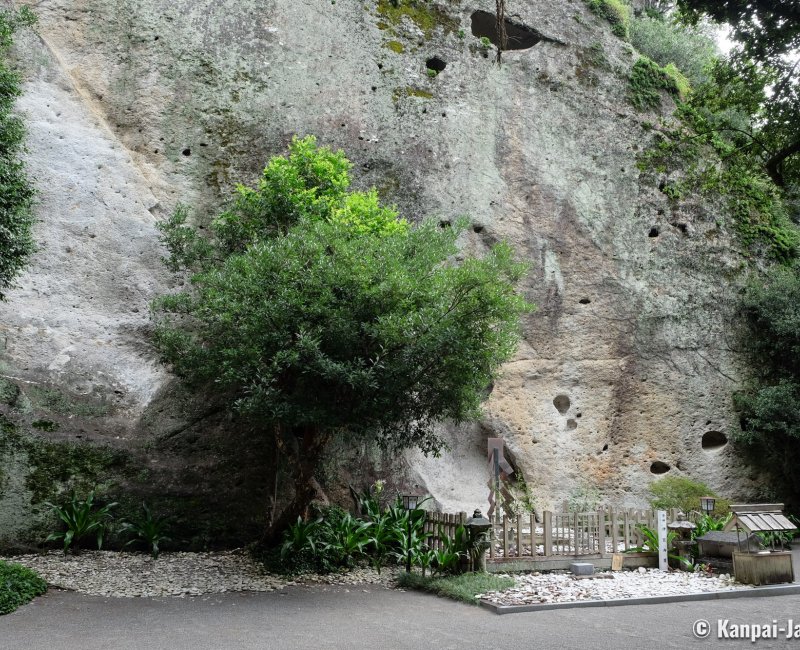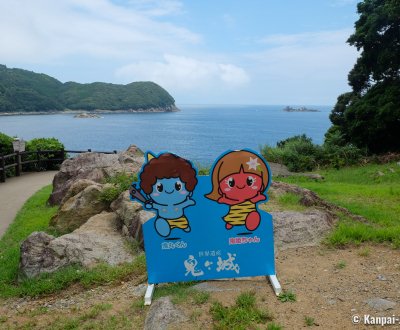Kumano
The Picturesque Stopover Town on the Iseji Route
Kumano is a city in the south of Mie Prefecture and at the limit with Wakayama and Nara prefectures. Located on the Kumano Kodo’s Iseji sacred route that connects Ise Grand Shrine to the Kumano Sanzan area, it still encompasses authentic portions of the old pilgrimage trail. Impressive weathered rock formations are also making the reputation of its coastline.
The east of the Kii peninsula is less walked by tourists and pilgrims but it nonetheless has a few beautiful destinations to discover, such as Kumano City. This little and peaceful town on the southern coast of Mie prefecture boasts several unusual and sacred highlights, that are worth the detour when exploring the area.

Onigajo Coastline
Shaped by earthquakes and the Pacific Ocean, the rock formations on Kumano’s coastline appear like genuine natural artworks. The cliffs were eroded by the waves, creating a mineral landscape of picturesque and jagged contours. A local belief says that oni demons used to live in these unique caves, hence the name of the seaside called Onigajo (鬼ケ城).
A one-kilometer artificial path running on the shore and hugging the cliff allows to get as close as possible to the rocks, but also to admire beautiful unobstructed views on the ocean. It is an awesome discovery that we highly recommended.

Matsumoto-toge Pass on the Kumano Kodo
Leave the seaside and walk to the heights to reach the Iseji Route, one of the ancient pilgrimage trails of the Kumano Kodo. While very few traces remain of the road, the handful of its preserved sections crossing the mountain range are beautiful. Among the most popular are:
- Matsumoto-toge Pass (松本峠) of an easy access from Onigajo Coastline; and,
- Magose-toge Pass (馬越峠), accessible from Owase city, located about thirty kilometers to the north of Kumano.
Hiking these sections listed in the UNESCO World Heritage is like a throwback in time during the Edo period (1603 – 1868) when a great number of pilgrims were treading the Iseji Route between Ise Grand Shrine and the Kumano Sanzan area.
The entrance of the Matsumoto Pass is located in the vicinity of the Hotel 🏨 Nami (ホテル なみ) in Kumano, where a car 🚙 parking was laid out a few meters away from the beginning of the path which is made noticeable thanks to a stairway and a stack of walking sticks. The hike to the highest point of the Pass at 135 meters altitude and the return trip is only one kilometer long. This short walk, and especially its stacked stones stairway, is one of the last authentic portions of the Kumano Kodo.
In the heart of the forest, an elevated paved path follows a stream of water. The ground is so hard that it prevents the trees’ roots to sink into it. Consequently, they grew on the surface and are very long to keep the trees standing. Intertwined with moss-covered stones, they offer a fascinating scenery befitting of the mystical atmosphere of the place.
The top of Matsumoto-toge is marked by guarding Jizo statues surrounded by bamboos and an elevated viewpoint on the coastline. From there, the large Shichiri-mihama beach 🏖 overlooked by the famous Shishi-iwa Lion Rock are clearly discernible.

Shishi-iwa rock and Shichiri-mihama beach
Shichiri-mihama (七里御浜海岸) is Japan’s longest gravel beach: it extends over more than twenty kilometers between Kumano city and Udono village, up to the mouth of the Kumano River. The sea currents being too strong, swimming is forbidden, but this long natural expanse is ideal for long walks and observing the local wildlife and vegetation. Shichiri-mihama pebbles are deemed sacred and therefore considered a valuable property of the region, so refrain from bringing some back home. On another note, numerous koi carp streamers ornament the site from the end of April in celebration of Kodomo no hi.
On Kumano’s side, the entrance of the beach is marked by the Shishi-iwa rock (獅子巖), listed in the UNESCO World Heritage as one of the "Sacred Sites in the Kii Mountain Range", for its unique natural silhouette resembling a roaring lion. In the same manner as a shrine’s komainu guardian, it is majestically watching over the seaside.

Hana-no-iwaya Shrine
Not far Shichiri-mihama coastline, Hana-no-iwaya (花の窟) Shrine, whose name literally means "flowers cave", is one of the most ancient Shinto place of worship in the archipelago. According to The Chronicles of Japan (Nihonshoki), the historical and mythological account of Japan and the imperial family’ divine origins, the place is linked to the death of the founder goddess Izanami.
The shrine’s characteristic lies in its Honden main hall that is not a man-made building but a pair of rocks, of which the biggest is 45 meters tall. Prayers are thus directed to the two rocks embodying the kami worshiped at the shrine: Izanami no Mikoto and her son Kagutsuchi (or Homusubi no Mikoto). Take off your shoes and walk on the sacred pebbles path, that were sourced at the Shichiri-mihama coastline. The solemn presence and the feeling of power emanating from the two rocks are bound to impress.
A ritual of rope changing named Otsunakake Shinji is performed twice a year in Hana-no-iwaya, in spring 🌸 and in autumn 🍁, that consists of stretching a 170-meters long cord between the large sacred rock and a tree, as a good omen. This matsuri is popular among the local and was designated Mie Prefecture’s "Intangible Folk Cultural Property".
On a side note: the touristic attractions mentioned here are concentrated in a limited area of the Kumano coastline and can easily be visited over a one-daytrip from the main station. A little bit further inland, the city is also home to Maruyama Senmaida (丸山千枚田), one of the largest and most beautiful terraced rice paddies in Japan.

